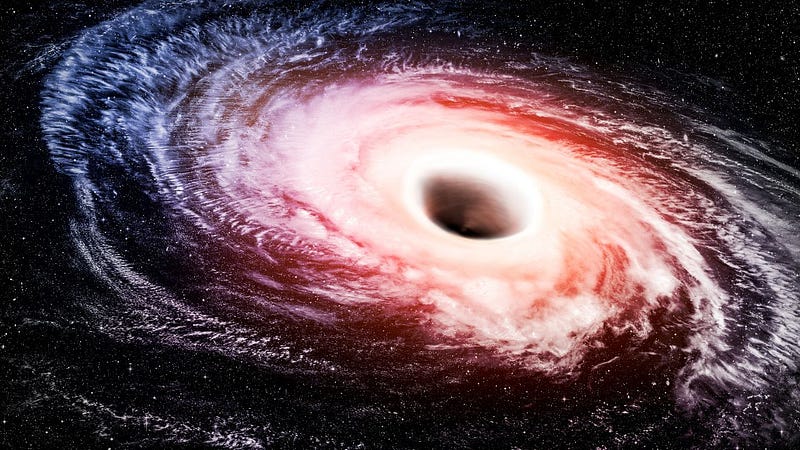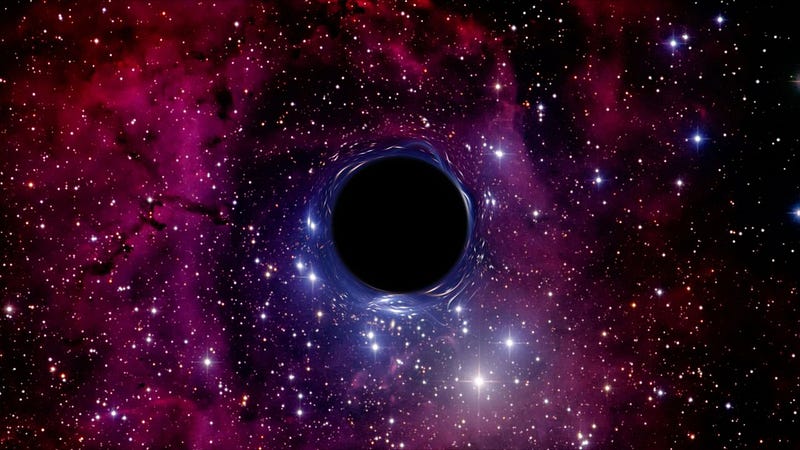Exploring the Enigmatic Nature of Black Holes in the Cosmos
Written on
Chapter 1: Understanding Black Holes
Black holes represent some of the most intriguing and enigmatic phenomena in our universe. These entities arise when a massive star succumbs to gravitational collapse, creating a void in space with an immensely strong gravitational force. This pull is so intense that even light cannot escape, rendering black holes invisible. In this discussion, we will delve into the theories surrounding black holes, their creation, characteristics, and the possible ramifications for our universe.
The genesis of black holes is intricately tied to the lifecycle of stars. Once a star depletes its nuclear fuel, it loses the ability to maintain the fusion processes that counteract gravitational collapse. If the star possesses sufficient mass, it collapses under its own weight, resulting in the formation of a black hole. The boundary beyond which nothing can escape is termed the event horizon.
One of the most captivating attributes of black holes is their influence on the fabric of space and time. According to Einstein's theory of general relativity, mass and energy distort space-time. Black holes exert such powerful gravitational forces that they warp space-time to an extraordinary extent, leading to a domain where time and space become unrecognizable. This peculiar area is referred to as the singularity, where conventional laws of physics cease to apply.

Section 1.1: Hawking Radiation
Another fascinating aspect of black holes is their ability to emit radiation, known as Hawking radiation. This phenomenon arises from quantum effects occurring near the event horizon. According to quantum theory, the vacuum of space is never truly empty; it is filled with fleeting pairs of particles and antiparticles. When this fluctuation occurs close to a black hole’s event horizon, one particle may be drawn into the black hole while the other escapes, manifesting as Hawking radiation.
The video "Black holes: the weirdest things in the Universe" explores these enigmatic entities and the peculiarities surrounding them.
Subsection 1.1.1: Types of Black Holes
Black holes can be categorized into various types based on their mass and properties. The most prevalent type is the stellar black hole, which forms from the collapse of a single massive star and can have a mass ranging from a few to several tens of times that of our sun. Intermediate black holes, with masses in the hundreds or thousands of solar masses, and supermassive black holes, found at the centers of galaxies and having masses in the millions or billions of solar masses, also exist.
Section 1.2: The Challenge of Observation
Despite their intriguing characteristics, black holes remain among the least comprehended objects in the universe. One major obstacle in studying them is their lack of visibility; since they do not emit light, direct observation is challenging. Instead, astronomers infer their existence and properties by observing their influence on neighboring stars and gas clouds.

Chapter 2: The Role of Black Holes in the Universe
Another significant challenge in black hole research lies in their positioning within some of the most extreme environments known. The gravitational forces near black holes are so intense that they can obliterate any object that strays too close. Consequently, studying black holes necessitates cutting-edge techniques and instruments capable of surviving such extreme conditions.
The documentary "Two Hours of Mind-Blowing Mysteries of Black Holes" offers an in-depth look at their role in the cosmos and the fundamental theories they challenge.
Black holes are crucial for enhancing our comprehension of the universe. They play an integral role in galactic evolution and star formation, and they also serve as a testing ground for fundamental physical theories like general relativity and quantum mechanics.
In addition to their scientific significance, black holes captivate public interest. They feature prominently in science fiction narratives, from films like "Interstellar" to literature such as Stephen Hawking's "A Brief History of Time." The notion of a realm where time and space are distorted evokes both wonder and fear.
The potential implications of black holes extend to humanity's future as well. Although the prospect of traveling to a black hole is remote, studying their behaviors and characteristics can deepen our understanding of the universe and our role within it. Some theorists even speculate that black holes could facilitate interstellar travel, paving the way for exploration beyond our solar system.
However, black holes may also pose threats to cosmic stability. A collision between two black holes could unleash a surge of gravitational waves, potentially disrupting the very fabric of space-time and affecting nearby stars and planets.
In summary, black holes are among the universe's most captivating and enigmatic phenomena. Formed from the collapse of massive stars, their gravitational forces are so powerful that they prevent light from escaping. Their distinctive properties challenge our understanding of the cosmos and hold potential consequences for humanity's future. Despite the difficulties inherent in studying them, black holes continue to captivate scientists and the public alike.